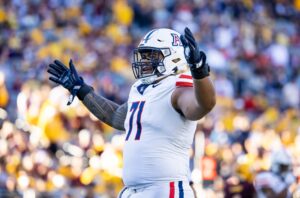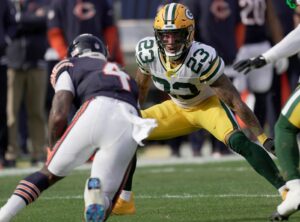Overview
Position: Wide Receiver
Height: 6’0”
Weight: 190 lbs
School: Alabama Crimson Tide
Combine Performance Data
40-yard dash: 4.27 seconds (best at 2020 Combine)
Vertical jump: 42 inches (tied for second-best among wide receivers)
Broad jump: 10 feet, 11 inches (tied for fourth-best among wide receivers)
Henry Ruggs 2020 NFL Draft Profile
To say that Henry Ruggs was a difference-maker during his collegiate tenure would be an understatement. Recruited as a five-star prospect out of Robert E. Lee High School, Ruggs chose to play at the University of Alabama for his home state school. Ruggs immediately made an impact for Alabama, earning a spot on the All-SEC freshman team after recording 12 receptions for 229 yards and six touchdowns. While he wasn’t yet a featured part of the offense, he still made his mark on special teams. The freshman returned 13 kickoffs for 239 yards to go along with eight punts for 46 yards.
Ruggs earned a starting spot during his second season with the Crimson Tide. Starring in one of the most talented teams in college football, the Alabama native broke out as one of the most exciting and electric players in college football. Ruggs ended the year with 46 receptions for 741 yards and 11 touchdowns, good for the second-most in the SEC. Additionally, Ruggs continued to play a big role on special teams and even earned Special Teams Player of the Week honors from his coaches on three separate occasions.
Henry Ruggs continued to build on his impressive collegiate record as a Junior. Even though Alabama didn’t win it all in 2019, Ruggs still managed to end the year with 40 receptions for 746 yards and seven touchdowns. Despite having one more year of eligibility, Ruggs decided to declare for the 2020 NFL Draft following his Junior year. In total, Ruggs ended his college career with 98 receptions for 1,716 yards and 24 touchdowns, averaging an absurd 17.5 yards-per-catch throughout his time at Alabama.
Strengths
- Breakneck speed with an ability to score every time he touches the ball
- Surprisingly effective red zone target considering his build
- Prefers to use speed to avoid defenders but isn’t afraid to lower the shoulder and break tackles
- Capable of lining up all over the formation
- Soft, reliable hands
- Can get off the line of scrimmage using a variety of techniques
- Can contribute on special teams
Weaknesses
- Isn’t the most polished route runner
- Rarely had to face top cornerbacks thanks to the presence of Jerry Jeudy
- Willing to block in the running game, but typically struggles to win his matchup
- Doesn’t have the widest catch radius
- Tends to wait for the ball to come to him, rather than attack it at the highest point
NFL Comparison: Brandin Cooks
Teams With Need at Position: New England Patriots, Philadelphia Eagles, Green Bay Packers, New York Jets, Las Vegas Raiders, Indianapolis Colts, Denver Broncos, Jacksonville Jaguars, Buffalo Bills
Projection: Mid-late first round
Bottom Line on Henry Ruggs
Henry Ruggs should be able to contribute in the NFL from Day 1. The Alabama product could very well be the fastest player in the upcoming NFL Draft and his explosiveness with the ball will translate to the NFL level. He plays larger than his size, isn’t afraid to run over the middle, and can score each and every time he touches the ball. His history as a returner is just the added cherry on top for NFL teams looking for a big-play threat at wide receiver.
Ruggs is good, but it’s hard to tell exactly how good he is in a vacuum. Opposing defenses always dictated coverage towards Jerry Jeudy, so Ruggs hasn’t had to deal with the pressure of being the top receiver in a passing attack. Additionally, like most collegiate receivers, Ruggs still needs to develop as a route runner. There is reason to believe he can do this, as precise route running isn’t as important in college as it is in the NFL. In the short-term, Ruggs should be a guy capable of playing a complementary role in an offense with massive big-play potential when schemed open. If he can continue to develop as a route runner, he should be an annual 1,000-yard receiver with double-digit touchdown potential.
Main photo:
Embed from Getty Images






